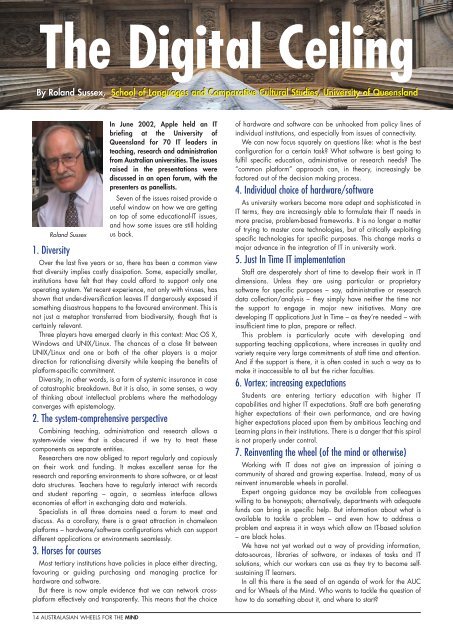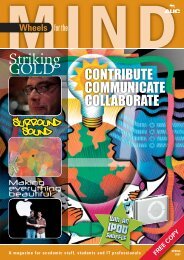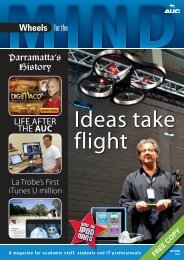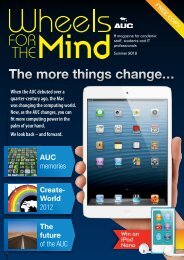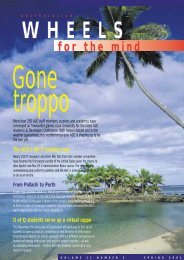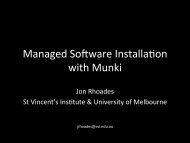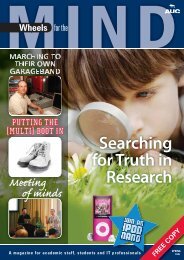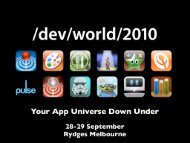for the mind - AUC
for the mind - AUC
for the mind - AUC
You also want an ePaper? Increase the reach of your titles
YUMPU automatically turns print PDFs into web optimized ePapers that Google loves.
The Digital Ceiling<br />
By Roland Sussex, School of Languages and Comparative Cultural Studies, University of Queensland<br />
By Roland Sussex, School of Languages and Comparative Cultural Studies, University of Queensland<br />
Roland Sussex<br />
In June 2002, Apple held an IT<br />
briefing at <strong>the</strong> University of<br />
Queensland <strong>for</strong> 70 IT leaders in<br />
teaching, research and administration<br />
from Australian universities. The issues<br />
raised in <strong>the</strong> presentations were<br />
discussed in an open <strong>for</strong>um, with <strong>the</strong><br />
presenters as panellists.<br />
Seven of <strong>the</strong> issues raised provide a<br />
useful window on how we are getting<br />
on top of some educational-IT issues,<br />
and how some issues are still holding<br />
us back.<br />
1. Diversity<br />
Over <strong>the</strong> last five years or so, <strong>the</strong>re has been a common view<br />
that diversity implies costly dissipation. Some, especially smaller,<br />
institutions have felt that <strong>the</strong>y could af<strong>for</strong>d to support only one<br />
operating system. Yet recent experience, not only with viruses, has<br />
shown that under-diversification leaves IT dangerously exposed if<br />
something disastrous happens to <strong>the</strong> favoured environment. This is<br />
not just a metaphor transferred from biodiversity, though that is<br />
certainly relevant.<br />
Three players have emerged clearly in this context: Mac OS X,<br />
Windows and UNIX/Linux. The chances of a close fit between<br />
UNIX/Linux and one or both of <strong>the</strong> o<strong>the</strong>r players is a major<br />
direction <strong>for</strong> rationalising diversity while keeping <strong>the</strong> benefits of<br />
plat<strong>for</strong>m-specific commitment.<br />
Diversity, in o<strong>the</strong>r words, is a <strong>for</strong>m of systemic insurance in case<br />
of catastrophic breakdown. But it is also, in some senses, a way<br />
of thinking about intellectual problems where <strong>the</strong> methodology<br />
converges with epistemology.<br />
2. The system-comprehensive perspective<br />
Combining teaching, administration and research allows a<br />
system-wide view that is obscured if we try to treat <strong>the</strong>se<br />
components as separate entities.<br />
Researchers are now obliged to report regularly and copiously<br />
on <strong>the</strong>ir work and funding. It makes excellent sense <strong>for</strong> <strong>the</strong><br />
research and reporting environments to share software, or at least<br />
data structures. Teachers have to regularly interact with records<br />
and student reporting – again, a seamless interface allows<br />
economies of ef<strong>for</strong>t in exchanging data and materials.<br />
Specialists in all three domains need a <strong>for</strong>um to meet and<br />
discuss. As a corollary, <strong>the</strong>re is a great attraction in chameleon<br />
plat<strong>for</strong>ms – hardware/software configurations which can support<br />
different applications or environments seamlessly.<br />
3. Horses <strong>for</strong> courses<br />
Most tertiary institutions have policies in place ei<strong>the</strong>r directing,<br />
favouring or guiding purchasing and managing practice <strong>for</strong><br />
hardware and software.<br />
But <strong>the</strong>re is now ample evidence that we can network crossplat<strong>for</strong>m<br />
effectively and transparently. This means that <strong>the</strong> choice<br />
of hardware and software can be unhooked from policy lines of<br />
individual institutions, and especially from issues of connectivity.<br />
We can now focus squarely on questions like: what is <strong>the</strong> best<br />
configuration <strong>for</strong> a certain task What software is best going to<br />
fulfil specific education, administrative or research needs The<br />
“common plat<strong>for</strong>m” approach can, in <strong>the</strong>ory, increasingly be<br />
factored out of <strong>the</strong> decision making process.<br />
4. Individual choice of hardware/software<br />
As university workers become more adept and sophisticated in<br />
IT terms, <strong>the</strong>y are increasingly able to <strong>for</strong>mulate <strong>the</strong>ir IT needs in<br />
more precise, problem-based frameworks. It is no longer a matter<br />
of trying to master core technologies, but of critically exploiting<br />
specific technologies <strong>for</strong> specific purposes. This change marks a<br />
major advance in <strong>the</strong> integration of IT in university work.<br />
5. Just In Time IT implementation<br />
Staff are desperately short of time to develop <strong>the</strong>ir work in IT<br />
dimensions. Unless <strong>the</strong>y are using particular or proprietary<br />
software <strong>for</strong> specific purposes – say, administrative or research<br />
data collection/analysis – <strong>the</strong>y simply have nei<strong>the</strong>r <strong>the</strong> time nor<br />
<strong>the</strong> support to engage in major new initiatives. Many are<br />
developing IT applications Just In Time – as <strong>the</strong>y’re needed – with<br />
insufficient time to plan, prepare or reflect.<br />
This problem is particularly acute with developing and<br />
supporting teaching applications, where increases in quality and<br />
variety require very large commitments of staff time and attention.<br />
And if <strong>the</strong> support is <strong>the</strong>re, it is often costed in such a way as to<br />
make it inaccessible to all but <strong>the</strong> richer faculties.<br />
6. Vortex: increasing expectations<br />
Students are entering tertiary education with higher IT<br />
capabilities and higher IT expectations. Staff are both generating<br />
higher expectations of <strong>the</strong>ir own per<strong>for</strong>mance, and are having<br />
higher expectations placed upon <strong>the</strong>m by ambitious Teaching and<br />
Learning plans in <strong>the</strong>ir institutions. There is a danger that this spiral<br />
is not properly under control.<br />
7. Reinventing <strong>the</strong> wheel (of <strong>the</strong> <strong>mind</strong> or o<strong>the</strong>rwise)<br />
Working with IT does not give an impression of joining a<br />
community of shared and growing expertise. Instead, many of us<br />
reinvent innumerable wheels in parallel.<br />
Expert ongoing guidance may be available from colleagues<br />
willing to be honeypots; alternatively, departments with adequate<br />
funds can bring in specific help. But in<strong>for</strong>mation about what is<br />
available to tackle a problem – and even how to address a<br />
problem and express it in ways which allow an IT-based solution<br />
– are black holes.<br />
We have not yet worked out a way of providing in<strong>for</strong>mation,<br />
data-sources, libraries of software, or indexes of tasks and IT<br />
solutions, which our workers can use as <strong>the</strong>y try to become selfsustaining<br />
IT learners.<br />
In all this <strong>the</strong>re is <strong>the</strong> seed of an agenda of work <strong>for</strong> <strong>the</strong> <strong>AUC</strong><br />
and <strong>for</strong> Wheels of <strong>the</strong> Mind. Who wants to tackle <strong>the</strong> question of<br />
how to do something about it, and where to start<br />
14 AUSTRALASIAN WHEELS FOR THE MIND


